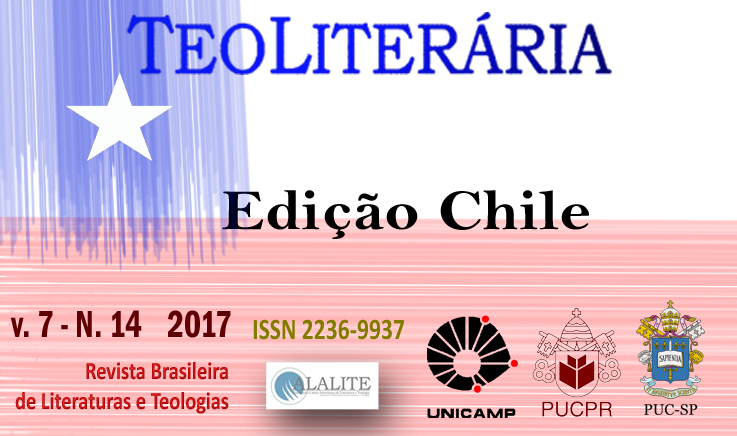T.S. Eliot and the tradition of Christian mysticism: the spatial paradox in Burnt Norton
DOI:
https://doi.org/10.19143/2236-9937.2017v7n14p55-69Palabras clave:
T.S. Eliot, Burnt Norton, Paradox, Christian Mysticism, Pseudo-DionysiusResumen
The present article seeks to identify T.S. Eliot’s affinity to the tradition of Christian mysticism by analyzing the spatial paradox in the poem Burnt Norton, the first of the Four Quartets. Parting from a general reflection on the importance of the paradox with regard to God’s ineffability, the poem is analyzed from a spatial perspective. It becomes obvious that the spatial paradox is not only used as an argumentative pattern, but also as a compositional key element that structures the whole text, generating a particular down-up-down dynamic. The most curios aspect, in this context, is that the poem continuously formulates and subsequently denies its own spatial movement, thus, in the end, also denying itself.Citas
Anonymous. The Cloud of Unknowing. Ed. Patrick J. Gallacher. Kalamazoo, Michigan: Medieval Institute Publications, 1997.
Augustine. Confessions. Translated by John K. Ryan. New York: Image Books, 1960.
Beierwaltes, Werner. Proklos. Grundzüge seiner Metaphysik. Frankfurt am Main: Klostermann, 1979.
Biblia Vulgata. Ed. Colunga, Alberto, and Laurentio Turrado. Madrid: Biblioteca de Autores Cristianos, 2015.
Carballo, Pablo Zambrano. La mística de la noche oscura: San Juan de la Cruz y T.S. Eliot. Huelva: Universidad de Huelva, 1996.
Cooper, John Xiros. The Cambridge Introduction to T.S. Eliot. Cambridge: Cambridge University Press, 2006.
Eliot, T.S. The Complete Poems and Plays. New York: Harcourt, Brace and Company, 1952.
Eliot, T.S. “Tradition and the Individual Talent”. The Sacred Wood. Essays on Poetry and Criticism. New York: Alfred A. Knopf, 1921: 42-53.
Gardner, Helen. The Composition of Four Quartets. London: Faber and Faber, 1978.
Gordon, Lyndall. T.S. Eliot: An Imperfect Life. New York: Norton, 1998.
Haas, Alios. “Das mystische Paradox”. Mystik als Aussage. Erfahrungs-, Denk- und Redeformen christlicher Mystik. Frankfurt am Main: Verlag der Weltreligionen, 2007a: 127-148.
Haas, Alios. “Überlegungen zum mystischen Paradox”. Mystik als Aussage. Erfahrungs-, Denk- und Redeformen christlicher Mystik. Frankfurt am Main: Verlag der Weltreligionen, 2007b: 149-171.
John of the Cross (Juan de la Cruz). Obras Completas. Edición Lucinio Ruano de la Iglesia. Madrid: Biblioteca de Autores Cristianos, 2009.
Köpf, Ulrich. “Aufstiegsschemata.” Wörterbuch der Mystik. Stuttgart: Kröner, 1998: 35–37.
Leitch, Vincent B.. “T.S. Eliot’s Poetry of Religious Desolation“. South Atlantic Bulletin. 44.2 (May 1979): 35-44.
Mansfeld, Jaap. “Heraklit.” Die Vorsokratiker I. Ed. Jaap Mansfeld. Stuttgart: Reclam, 2008: 231–243.
Murray, Paul. T.S. Eliot and Mysticism. The Secret History of Four Quartets. London: Macmillan, 1991.
Nicklas, Pascal. “Lotos”. Metzler Lexikon literarischer Symbole. Herausgegeben von Günther Butzer. Stuttgart: Metzler, 2012: 251-252.
Pseudo-Denys (Dionysius the Areopagite). The Divine Names and Mystical Theology. Trans. C. E. Rolt. London: Society for the Propagation of Christian Knowledge, 1920
Descargas
Publicado
Cómo citar
Número
Sección
Licencia
Derechos de autor 2017 Teoliteraria - Revista de Literaturas y Teologías (On Line) ISSN 2236-9937

Esta obra está bajo una licencia internacional Creative Commons Atribución 4.0.
La Teoliteraria - Revista Brasileira de Literaturas e Teologías es detentora de los derechos autorales de todos los artículos publicados por ella. La reproducción total de los artículos de ésta revista en otras publicaciones, o para cualquier otro fin, por cualquier medio requiere autorización por escrito del editor de este periódico. Reproducciones parciales de artículos (resúmenes, abstrac, más de 500 palabras de texto, tablas, figuras y otras ilustraciones) deberán tener permiso por escrito del editor y de los autores.

